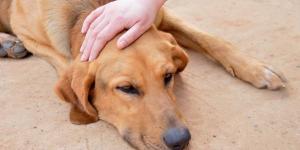My Dog Is Losing a Lot of Weight - Cachexia in Dogs



See files for Dogs
Dogs are known for their voracious appetites, but not all dogs have the same metabolism. Whether a dog loses or gains weight easily will depend on many factors, genetic inheritance due to breed being only one of them. However, when a dog loses or gains a significant amount of weight, it is always something we need to address. Obesity can lead to many health problems, as can anorexia. When a dog loses so much weight fat and muscle starts to decay, it means they are faced with a significant health problem. This type of weight loss is known as cachexia.
At AnimalWised, we find out why my dog is losing a lot of weight. We do so by looking at cachexia in dogs, specifically the causes, symptoms and treatment which characterize this syndrome.
What is cachexia in dogs?
Cachexia consists of severe loss of body weight, fat, and muscle. Rather than a disease or symptom, it is a syndrome. This means it is recognized as a set of clinical signs that can appear associated with various pathologies. What they all have in common is that they result in a negative energy balance.
For reasons that we will explain later, when an animal enters into an energy deficit, they begin to metabolize glycogen which is stored as a reserve in tissues such as the liver or muscles. These deposits are limited and only provided energy for around 2-3 days. After this time, the body begins to metabolize subcutaneous and abdominal fat. Once these stores are used up, they catabolize proteins, first muscle proteins then those found in glandular tissue.
In these cases the dogs will lose a lot of weight. Not only will they appear thin, they will look dangerous thin and their bones will protrude through their skin.
Types of cachexia in dogs
There are different types of cachexia in dogs, each one associated with certain pathologies. The most well-known are associated with the following:
- Cardiac cachexia: consists of weight loss in dogs with congestive heart failure (CHF). In these patients, energy consumption increases as a consequence of sympathetic activation, putting increased strain on breathing, and resulting in tachycardia (abnormally increased heart rate).
- Tumor cachexia: consists of weight loss as a consequence of the development of a tumor. In cancer patients, there is an increase in basal metabolism because the tumor requires a lot of energy to grow. To do so, it rapidly metabolizes carbohydrates and proteins. In addition, many cancer patients receive chemotherapy, which contributes to weight loss.
However, there are many other causes that can cause cachexia in dogs. We explain some of the most common below. If you want to learn more about why a dog loses weight, take a look at our article on why a dog is skinny, but still eating.
Causes of cachexia in dogs
The causes of cachexia in dogs can be grouped into three broad categories: those that imply an insufficient intake of nutrients, those that entail and increase in energy requirement and those that result from a loss of nutrients. The latter can be due to problems with the digestive system, urinary tract, etc. The main causes of cachexia in dogs include:
- Anorexia: it is important we differentiate between anorexia as a psychological condition and anorexia as a clinical symptom. Only the latter appears to present in dogs. In these cases, a total loss of appetite usually appears to be more a consequence of cachexia than a cause. However, in cachectic animals a positive feedback loop between their progressive weakening and the absence of appetite can be found. I.e., cachexia causes anorexia and vice versa.
- Deficient diet: when a dog is not provided with the right nutrition, they will have a negative energy balance. This means they burn more energy than they intake. This doesn't only happen when the dog isn't given enough food, it occurs when the food they eat is nutritionally deficient. This is one reason why it is so important homemade diets for dogs meet their nutritional requirements.
- Increased basal metabolic rate: occurs in case of fever, infectious diseases, trauma and tumors. In the case of tumors, it will be considered tumor cachexia. To know more, take a look at our article on skin tumors in dogs.
- Congestive Heart Failure (CHF): in patients with heart failure there is an increase in energy requirements due to the activation of the sympathetic nervous system (SNS), increased effort required to breathe and tachycardia. This is when we can see cardiac cachexia.
- Malabsorption syndrome: a condition which can appear in infectious and parasitic diseases, neoplasms, inflammatory processes (e.g. enteritis in dogs), lymphangiectasia and intestinal obstructions. In all these cases, the digestion of food is carried out correctly, but there is an alteration in the absorption of nutrients. The result is nutritional deficiencies and a significant loss of weight.
- Loss of nutrients: it can be the loss of glucose through the urine in dogs with diabetes, the loss of protein through the urine in kidney diseases or the loss of protein through the digestive system in enteropathies (diseases of the intestine). The latter can include parasitical infestation or infection.
Consequences of cachexia in dogs
Some of the consequences of cachexia in dogs are related to different body systems. They include:
- Musculoskeletal system: since muscle proteins are catabolized, we can see them lose muscle and bones start to protrude. The bones may even be more malleable to the touch.
- Reproductive system: there are alterations in spermiogenesis (sperm production) in dogs and in the estrous cycle in bitches. In case of pregnancy, abortions occur frequently.
- Immune system: there is both a cellular-based and humoral-based immunosuppression. Once the immune system is suppressed, they are much more vulnerable to secondary infections and diseases.
- Blood: decreases hematopoiesis (production of blood cells) and plasma proteins.
- Digestive system: there is a progressive atrophy of the intestinal mucosa that gives rise to a malabsorption syndrome. Consequently, malabsorption syndrome results in chronic diarrhea which aggravates the cachexia.
If puppies or young dogs have cachexia, their growth rate will decrease. In the case of cachectic animals that must undergo surgery, we must also consider that the level of tissue regeneration will be decreased.
Diagnosis of cachexia in dogs
When you see your dog has lost a lot of weight, we must first check to see if their appetite is normal. In cases where the appetite is decreased (hyporexia or anorexia), we will have to determine the cause. If their appetite remains normal, we should consider their portioning since they may simply be not eating enough for their metabolic needs.
In cases where the diet is correct, but the dog still loses a lot of weight, we need to go to the veterinarian for a differential diagnosis. They will examine the dog and run any relevant tests to see why their metabolism has been affected in such a way to cause rapid weight loss. The diagnostic protocol generally includes:
- Anamnesis: a detailed veterinary medical history.
- Complete physical examination: in which special attention must be paid to the body condition of the animal.
- Complementary diagnostic tests: depending on the list of differential diagnoses that we have prepared based on the anamnesis and physical examination, laboratory tests (such as blood and/or urine tests, stool tests, cytologies, etc.) and diagnostic imaging tests (x-ray, ultrasound, CT or MRI) will be carried out. See our related article to know how to understand a dog's blood test.
It is important our veterinarian makes an early diagnosis to improve the prognosis and the effectiveness of the treatment.

Treatment for cachexia in dogs
The treatment of cachexia in dogs will depend directly on the underlying cause which results in the dog losing a lot of weight. In general, we can differentiate three types of treatment:
- In case of anorexia: a treatment will have to be instituted depending on the cause of the anorexia.
- In the case of dietary deficiency: it will be necessary to establish a diet according to the nutritional and energy needs of our dog. These will take into account age, physical activity and physiological state. In this case, it will be especially important to consult a veterinarian who specializes in animal nutrition, to guarantee a healthy, complete and balanced diet for our dog.
- In the case of pathologies: disease cause an increase in metabolic expenditure or a loss of nutrients by any means will require a specific treatment to counteract them. In the case of bacterial infections, this may require antibiotics. For some diseases, such as those which lead the dog to be immunocompromised, symptom management may be required over the long term.
You will need to follow the veterinarian's advice carefully. However, if your dog has lost a lot of weight, you can discuss the ways you can put weight on a dog with them to see what else you can do.

This article is purely informative. AnimalWised does not have the authority to prescribe any veterinary treatment or create a diagnosis. We invite you to take your pet to the veterinarian if they are suffering from any condition or pain.
If you want to read similar articles to My Dog Is Losing a Lot of Weight - Cachexia in Dogs, we recommend you visit our Other health problems category.
- Escorza, B. M., & Hernández, G. A. (2021). Sarcopenia and cachexia: manifestations of disease in geriatric dogs and cats. Faculty of Veterinary and Zootechnical Medicine, UNAM.
- Nelson, R. W., & Couto, C. G. (2014). Small animal internal medicine. Elsevier.
- Parker, J. (2018). Sarcopenia of aging and cachexia in dogs and cats. Proceedings.






